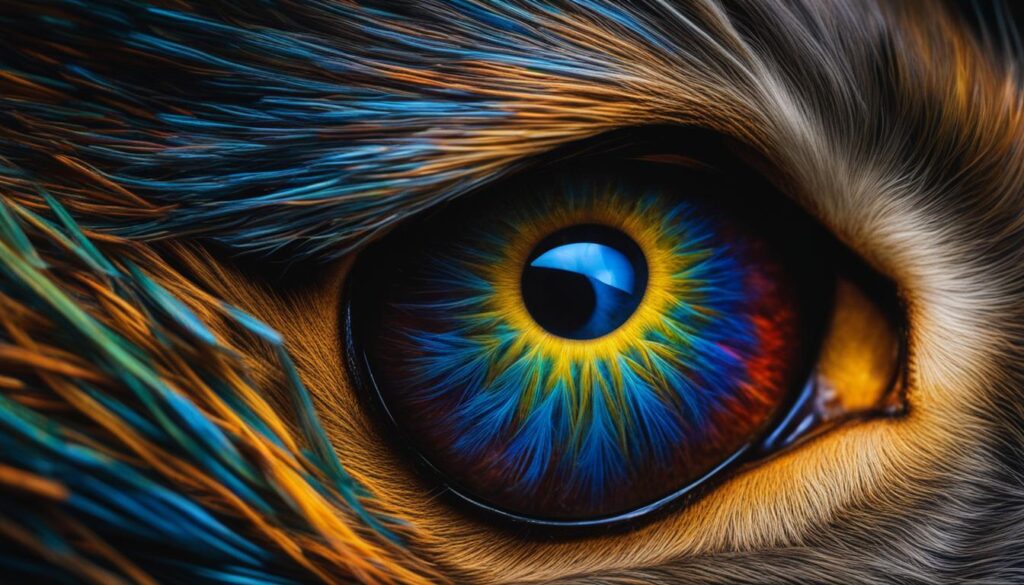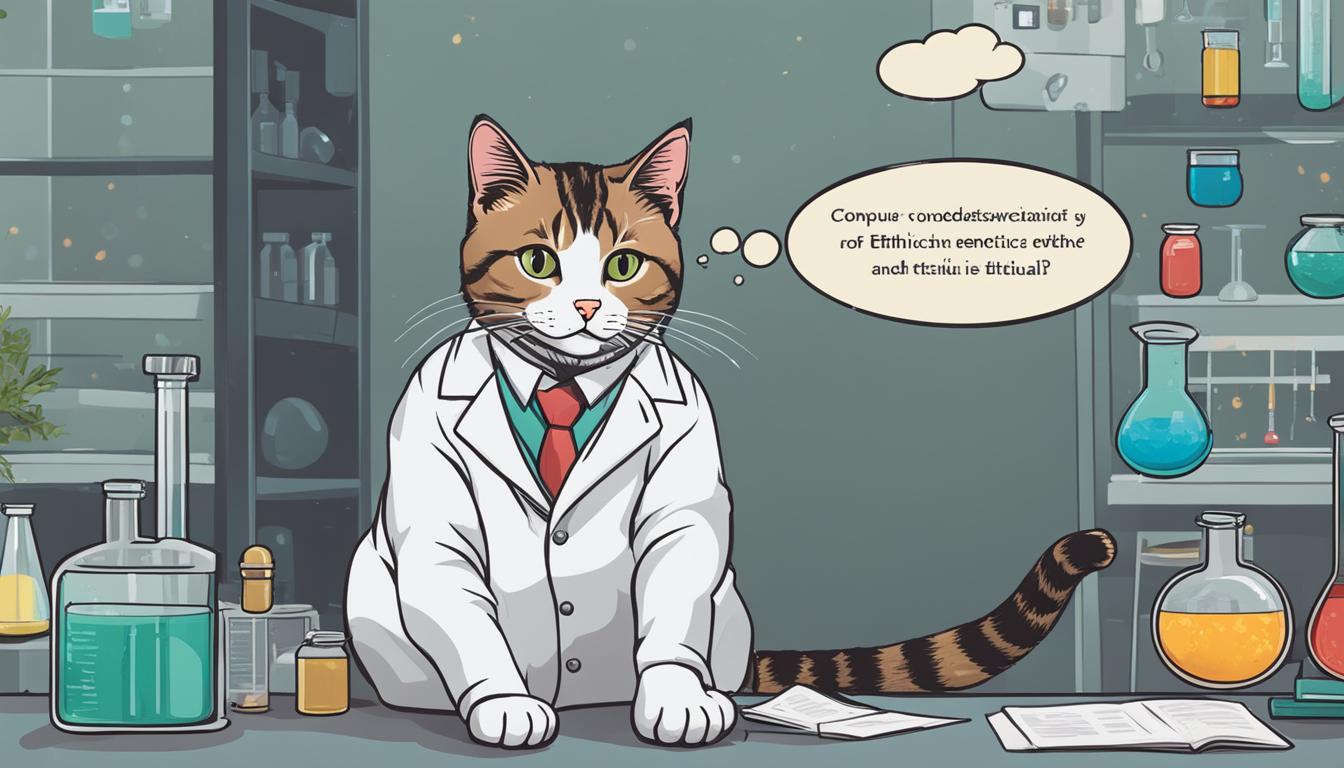Oh, the enigmatic feline! With their inscrutable gazes and mysterious ways, cats have captivated our hearts for centuries. But have you ever wondered what secrets lie within their DNA? Join me on a fascinating journey as we delve into the world of feline genetics and unravel the mysteries hidden in the feline genome.
Mapping the feline genome, deciphering the intricacies of cat DNA – these are not just endeavors of curiosity, but hold immense potential for the future of feline biology, behavior, and veterinary care. Through extensive research on the feline genome, we aim to understand the genetic makeup of cats, their origins, and how these genetic factors influence their health and well-being.
Key Takeaways:
- Mapping the feline genome is essential for understanding feline biology and advancing veterinary care.
- Feline genome mapping research involves studying domestication, migration patterns, and breed origins.
- Genomic medicine in cats has the potential to predict and develop personalized treatments for diseases.
- A high-quality domestic cat genome reference and accessible community database are necessary for implementing genomic medicine in feline practice.
- The feline genome provides insights into both veterinary and model organism genomics.
The Value of the Feline Genome for Veterinary and Model Organism Genomics
Genomic research on cats has great significance for both the veterinary field and model organism studies. Cats, as obligate carnivores, offer valuable insights into the genetic makeup of endangered felid species and serve as an ideal model for understanding various aspects of feline biology. The Felis catus genome assembly, which serves as the foundation for feline genomic studies, has provided researchers with a framework for investigating feline genetics and biology.
By analyzing the cat genetic code, researchers have been able to identify and characterize additional protein coding sequences, addressing some gaps in our understanding of the feline genome. These sequences offer valuable information on feline development, nutrition, health, and their relationship to human genes associated with Mendelian disorders. Comparative genomic analyses have also revealed conserved mammalian biology as well as cat-specific biological features within the feline genome.
To further explore the feline genome, researchers have focused on studying cat behavior and intelligence. Understanding the genetic basis of feline behavior has been a challenge due to their solitary nature and complex social interactions. However, researchers have identified several signals in feline behavior, such as purring, meowing, ear positions, tail movements, and different social behaviors. Ongoing research aims to unravel the mysteries of feline cognition and intelligence, shedding light on how genetics influence their behavior.
| Feline Genome Research Highlights | Significance |
|---|---|
| Identification and characterization of additional protein coding sequences | Provides insights into feline development, nutrition, and health |
| Comparative genomic analyses | Reveals conserved mammalian biology and cat-specific features |
| Study of feline behavior and intelligence | Provides understanding of how genetics influence feline behavior |
In conclusion, the feline genome carries immense value for veterinary medicine and model organism genomics. By deciphering the genetic code of cats, researchers gain insights into feline biology, behavior, and genetics. This knowledge has the potential to revolutionize veterinary care and contribute to the conservation efforts of endangered felid species. With ongoing research and advancements in genomic technologies, the future of feline genomics holds great promise.

Exploring the Mind of a Cat
Understanding the intricacies of feline behavior and intelligence has always been a fascinating challenge for researchers. Unlike their canine counterparts, cats have a more solitary nature and engage in less complex social interactions, making their behavior difficult to decipher. Additionally, studying cats in a laboratory setting can be challenging as they often become nervous outside their own territory. However, despite these obstacles, scientists have made significant strides in unraveling the mysteries of the feline mind.
One of the key ways researchers have approached this task is by analyzing various signals in feline behavior. From purring and meowing to ear positions, tail movements, and social behaviors such as rubbing and grooming, these subtle cues provide valuable insights into the inner workings of a cat’s mind. By studying these behaviors, researchers hope to gain a better understanding of feline cognition and intelligence.
While there is still much to learn about the intricacies of feline behavior, ongoing research in this field holds promise for unlocking the secrets of the feline mind. By combining insights from genetic studies, behavioral observations, and cognitive testing, scientists aim to deepen our understanding of cats and provide valuable insights into their behavior and intelligence.

The Curious Case of the Cuddly Cognoscenti
“Cats have always captivated our attention with their elusive yet endearing behavior. By delving into the genetic makeup of cats and decoding their behaviors, we hope to shed light on the fascinating world of feline cognition.” – Dr. Meowster, Feline Behaviorist
The Language of Cats
Cats are known for their unique ways of communication. They use a combination of vocalizations, body language, and behaviors to express their thoughts and feelings. Understanding the language of cats can provide valuable insights into their needs, emotions, and social interactions.
The Purr: A Multifunctional Sound
“Purrs are the soft whispers of a cat’s contentment.”
Cats use purring as a way to communicate various emotions and needs. While purring is commonly associated with contentment, it can also express other feelings such as stress, pain, or urgency. It serves as a means for cats to communicate with their human companions, signaling their desire for attention, food, or a comforting presence.
Meows: A Language for Humans
“Meows are cats’ way of speaking our language.”
Unlike purrs, meows are not used in cat-to-cat communication. Instead, cats have developed a repertoire of meows specifically for human interaction. Each meow has a distinct meaning, from a greeting to a request for food. Through their meows, cats have learned to adapt their communication to effectively convey their needs and desires to their human companions.
Body Language: Silent yet Expressive
“A cat’s body language is like a silent conversation.”
Cats communicate a wealth of information through their body language. Ears held back can signal aggression or fear, while forward-facing ears indicate interest or curiosity. Tail positions can convey a range of emotions, from happiness to insecurity or even anger. Rubbing their head and face on objects is a way of marking territory and can also be a sign of affection. Lying on their back with their belly exposed is a display of relaxation and trust. Kneading behavior is often seen as a sign of affection and may be reminiscent of their nurturing role as kittens. Licking behavior is a demonstration of grooming and bonding within a feline social circle.
Understanding the language of cats requires observation, intuition, and a keen eye for interpreting their cues. By paying attention to their vocalizations, body language, and behaviors, we can deepen our bond with these fascinating creatures and provide them with the care and understanding they deserve.

Cat Communication Cheat Sheet
| Sound/Behavior | Meaning |
|---|---|
| Purring | Contentment, comfort, or seeking attention |
| Meowing | Varies depending on tone and context, can indicate greetings, requests, or complaints |
| Ears held back | Aggression, fear, or anxiety |
| Ears forward | Interest, curiosity, or alertness |
| Tail held high | Happiness or confidence |
| Tail tucked between legs | Fear, insecurity, or submission |
| Rubbing head and face on objects | Territory marking, affection, or familiarity |
| Lying on back with belly exposed | Relaxation, trust, or invitation to play |
| Kneading | Affection, comfort, or reminiscing behavior from kittenhood |
| Licking | Grooming, bonding, or displaying affection within the cat social circle |
The Genetic Legacy of Cats
Research on the feline genome has provided valuable insights into the genetic makeup of cats, shedding light on their evolutionary history and the unique traits that make them the beloved companions they are today. The feline genome mapping research has revealed that the domestic cat’s genetic legacy dates back nearly 10,000 years to its split from its wild counterpart in the Middle East.
One of the key findings from studying the feline genome is the role of genes linked to behavior in the domestication process. Cats have been shaped by genes associated with learning ability and reduced fearfulness, attributes that have played a crucial role in their transformation from wildcats to our cuddly companions. These genetic adaptations have not only influenced their behavior but have also contributed to the development of their unique cognitive abilities.
However, despite the progress made in understanding the genetic legacy of cats, there is still much to uncover about feline cognition and intelligence. Cats are known for their independent nature, which is reflected in their problem-solving abilities and behavior. Further research is needed to unravel the intricacies of feline cognition and determine the extent to which their genetic makeup contributes to their cognitive capabilities.
| Key Findings | Implications |
|---|---|
| Feline genetic legacy dating back 10,000 years | Understanding the ancestral roots of domestic cats |
| Genes linked to behavior shaping domestication | Insights into the cognitive abilities of cats |
| Role of independence in problem-solving abilities | Exploring the genetic basis of feline intelligence |
Our findings on the genetic legacy of cats highlight the rich history and fascinating evolution of these enigmatic creatures. By studying the feline genome, we gain a deeper understanding of the genetic adaptations that have shaped cats’ behavior and cognitive abilities over thousands of years. The ongoing research in feline genome mapping research is crucial for unraveling the mysteries of feline genetics and cognition, bringing us one step closer to fully decoding the feline genome.
Study of Genetic Makeup in Cats
The study of genetic makeup in cats goes beyond unraveling the mysteries of their cognitive abilities. It also plays a crucial role in improving feline health and well-being. By analyzing the feline genome, researchers can identify genetic variations associated with certain diseases and conditions in cats, paving the way for targeted treatments and preventative measures.
Feline genome mapping research has already yielded significant insights into diseases prevalent in specific cat breeds. For example, studies have identified genetic markers associated with conditions such as hypertrophic cardiomyopathy in Maine Coon cats and polycystic kidney disease in Persians. These discoveries not only aid in early diagnosis and treatment but also support responsible breeding practices to reduce the prevalence of these inherited diseases.
Furthermore, the study of genetic makeup in cats has implications beyond feline health. Cats share many genetic similarities with humans, making them valuable models for studying human genetic disorders. By understanding the genetic basis of diseases in cats, researchers can gain insights into the underlying mechanisms and potential treatments for similar conditions in humans. This cross-species approach enhances our understanding of both feline and human genetics, benefiting both species in the quest for improved health and well-being.
Challenges in Studying Cats
Studying cats presents unique challenges in the field of feline genetics and behavior research. Unlike their canine counterparts, cats have a solitary nature and are known to become nervous when removed from their familiar environment. This poses difficulties in conducting controlled experiments and laboratory studies on cats, limiting our understanding of their genetic code and cognitive abilities.
Because cats are highly territorial animals, their behavior can vary significantly depending on their home environment. This means that most studies on feline genetics and behavior rely on observations within the home setting. While this provides valuable insights, it also introduces additional factors that can influence cat behavior, making it more challenging to isolate genetic factors from environmental ones.
Furthermore, the inherent differences between cat behavior and dog behavior have contributed to the gap in our knowledge of feline cognition and intelligence. Cats have a more independent nature and approach problem-solving in their own unique way. This requires researchers to develop specialized methods and approaches tailored specifically for studying cats and decoding their genetic makeup.
“Studying cats poses unique challenges compared to dogs due to their solitary nature and difficulty in laboratory settings.”
Despite these challenges, ongoing research using comparative genomics methods and observational studies continues to shed light on the behavior and genetics of cats. By studying cats in their natural environment and comparing their genetic code to other species, researchers can unravel the mysteries of the feline genome and deepen our understanding of their unique biology.

The Challenges of Studying Cats:
- Solitary nature and difficulty in laboratory settings
- Dependence on home environment for behavior studies
- Unique problem-solving approach
| Challenges | Solutions |
|---|---|
| Solitary nature and difficulty in laboratory settings | Develop specialized methods for studying cats in their own environment and minimize stress during experiments. |
| Dependence on home environment for behavior studies | Combine observational studies in the home environment with controlled experiments in laboratory settings to gain a comprehensive understanding of feline behavior. |
| Unique problem-solving approach | Design experiments and tests that cater to the independent nature of cats and their distinctive problem-solving techniques. |
The Future of Feline Genomic Medicine
As advances in feline genetic research continue to unfold, the study of the genetic makeup in cats holds immense promise for the future of feline healthcare. The cat genome project has paved the way for a deeper understanding of feline biology, behavior, and genetics, opening doors to personalized treatments and improved veterinary care.
With ongoing research and technological advancements, we can expect significant progress in the field of feline genomics. The study of genetic makeup in cats will provide valuable insights into breed-specific diseases, helping veterinarians tailor treatment plans based on individual cat breeds’ genomic variants. This personalized approach to feline healthcare has the potential to revolutionize how we diagnose and treat diseases in our feline companions.
However, to fully harness the power of feline genomic medicine, further research is needed. Continued exploration of the feline genome, advancements in sequencing technologies, and the establishment of comprehensive community databases will be vital in unlocking the full potential of genomic medicine in cats. By building upon the foundations laid by the cat genome project, we can pave the way for a future where personalized healthcare for cats is a reality.
Conclusion
As I wrap up my exploration of the feline genome, I am amazed by the endless possibilities it holds. Feline genome mapping research has allowed us to delve deep into the intricate world of cat DNA, unraveling the secrets of their genetic makeup.
Decoding cat DNA is not just an academic pursuit, but a gateway to understanding feline biology, behavior, and genetics on a whole new level. Through genetic exploration of the cat genome, we can predict and develop personalized treatments for diseases in feline populations, paving the way for a healthier future for our feline friends.
However, the journey to fully comprehend the feline genome is not without its challenges. The solitary nature of cats, combined with the difficulties of studying them in laboratory settings, have posed obstacles along the way. But with ongoing feline genome mapping research, comparative genomics methods, and observational studies, we are steadily filling in the gaps and getting closer to unlocking the mysteries of the feline genome.
So, let us continue our quest for knowledge, embracing the excitement of genetic exploration in the world of cats. Together, we can decode the cat DNA, painting a clearer picture of their biology, behavior, and the unique traits that make them the fascinating creatures we adore.
FAQ
What is genomic medicine and how can it be applied in cats?
Genomic medicine involves using an individual’s genes, environment, and lifestyle to predict disease treatment and prevention strategies. In cats, genomic medicine can be applied to common and rare diseases, particularly in the field of oncology where driver gene mutations can help identify and eliminate cancer relapse.
What is the current state of the feline genome research?
Research on the feline genome aims to understand feline DNA through studies on domestication, migration patterns, breed origins, and unique molecular signatures. However, before genomic medicine can be implemented in feline practice, there is a need for a high-quality domestic cat genome reference, sufficient sequence variation across different cat breeds, and an accessible community database.
How can the feline genome be valuable for veterinary and model organism genomics?
The feline genome is valuable for both the veterinary and model organism genomics communities. Cats serve as a model for endangered felid species and the Felis catus genome assembly provides a framework for studying feline biology. Understanding the feline genome can help develop personalized treatments for diseases in feline populations.
What challenges are there in studying feline behavior and intelligence?
Cats have a solitary nature and less complex social interactions compared to dogs, making their behavior and intelligence more difficult to decipher. Cats are also difficult to study in the laboratory as they become nervous outside of their own territory. However, researchers have identified several signals in feline behavior that can help unravel the mysteries of feline cognition and intelligence.
How do cats communicate through vocalizations and body language?
Cats communicate through a variety of vocalizations, body language, and behaviors. The purr can express emotional states, urgency, and stress or injury. Cats develop a repertoire of meows to communicate with humans. Ears back signal aggression, ears forward indicate interest. Tail positions can indicate fondness, anger, or insecurity. Cats rubbing their head and face on objects marks territory and may signal affection. Lying on their back with the belly exposed shows relaxation and trust. Kneading behavior is thought to be affectionate. Licking behavior is a demonstration of affection and bond-building within a cat society.
What is the genetic legacy of domestic cats?
The domestic cat’s genetic legacy dates back nearly 10,000 years to its split from its wild counterpart in the Middle East. Genes linked to behavior, including learning ability and reduced fearfulness, played a crucial role in the transformation of wildcats into our domesticated companions. Further research is ongoing to fully understand feline cognition and intelligence.
What are the challenges faced in studying cats compared to dogs?
Studying cats poses unique challenges compared to dogs due to their solitary nature and difficulty in laboratory settings. Cats become nervous when taken out of their own homes, making controlled experiments challenging. As a result, most studies on cats are based on observations in the home environment. Ongoing research using comparative genomics methods and observational studies can continue to improve our understanding of feline genetics and behavior.
What is the future of feline genomic medicine?
Genomic medicine holds great promise for delivering personalized healthcare based on an individual’s genes, environment, and lifestyle. In the future, the application of genomic medicine in cats may involve treating specific cat breeds based on their genomic variants. However, before feline genomic medicine can be widely practiced, the feline genome needs to be further studied and understood.





